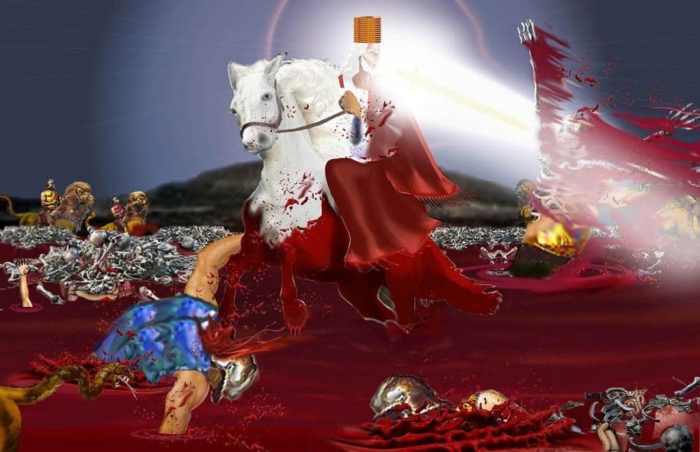In Grapes of Wrath Chapter 19, John Steinbeck masterfully weaves a tapestry of human resilience and struggle against the backdrop of the Great Depression. This chapter delves into the lives of the Joad family as they navigate the harsh conditions of a government camp and confront the social and economic injustices that plague their existence.
As the Joads grapple with poverty, exploitation, and the unforgiving elements, the chapter explores the profound impact of these hardships on their relationships and their indomitable spirit.
Character Development: Grapes Of Wrath Chapter 19
Tom’s transformation and his emerging leadership role are significant in Chapter 19. Tom has matured and become more assertive, recognizing the need for action and unity within the camp. He challenges Casey’s authority and advocates for the rights of the migrant workers, demonstrating his newfound confidence and determination.
The Joad Family’s Resilience
The Joad family’s resilience is tested as they face further adversity in the camp. Despite the harsh conditions and the threat of violence, they remain determined to survive and maintain their dignity. Their resilience is evident in their ability to adapt to the camp’s rules and regulations, and their willingness to support each other in times of need.
Evolving Relationships and Dynamics
The characters’ relationships and dynamics evolve within the camp. Tom and Casy’s friendship deepens as they work together to improve conditions for the migrant workers. Al Joad and Aggie Wainwright’s relationship blossoms, providing a source of comfort and support amidst the hardships of camp life.
The Joad family’s bond is strengthened as they face challenges together, reinforcing their unity and interdependence.
Setting and Symbolism

The government camp provides a stark and unforgiving environment for the migrant workers. The tents are overcrowded and unsanitary, with little privacy or protection from the elements. The food is meager and monotonous, and the workers are constantly plagued by illness and disease.
The atmosphere is one of desperation and despair, as the workers struggle to survive in these harsh conditions.
Symbolism of the “Grapes of Wrath”, Grapes of wrath chapter 19
The “grapes of wrath” are a powerful symbol of the struggles of the migrant workers. The grapes represent the promise of a better life, but they also represent the exploitation and oppression that the workers face. The workers are forced to work long hours in the fields for little pay, and they are often subjected to violence and abuse.
The grapes of wrath are a reminder of the bitter reality of the migrant workers’ lives.
Significance of the Dust Storms
The dust storms are a recurring motif in The Grapes of Wrath. They symbolize the destructive power of nature and the harsh conditions that the migrant workers must face. The dust storms also serve as a metaphor for the economic and social upheaval of the Great Depression.
The storms destroy crops and homes, and they force the workers to move on in search of a better life.
Social and Economic Issues

The novel “The Grapes of Wrath” by John Steinbeck exposes the harsh exploitation and poverty faced by migrant workers during the Great Depression. Through the experiences of the Joad family, Steinbeck vividly portrays the systemic injustices and social struggles that plagued the working class in rural America.
Exploitation of Migrant Workers
- Migrant workers were forced to accept meager wages and live in squalid conditions, often in overcrowded labor camps.
- They faced constant threats of eviction, deportation, and violence from employers and authorities.
- The lack of legal protections and unions left workers vulnerable to exploitation and abuse.
Government Aid and the Joad Family
Government aid programs, such as the Federal Emergency Relief Administration (FERA) and the Farm Security Administration (FSA), provided some temporary relief to the Joad family.
- FERA provided food and cash assistance, which helped to alleviate immediate hunger and hardship.
- The FSA established resettlement camps, offering housing, medical care, and agricultural training.
- However, government aid was often inadequate and subject to bureaucratic delays, leaving many families still struggling.
Themes of Social Injustice and Class Conflict
The novel explores the themes of social injustice and class conflict, highlighting the vast economic disparities and the struggle for workers’ rights.
- The wealthy landowners and corporations control the means of production and exploit the labor of migrant workers.
- The working class is impoverished and disenfranchised, with limited opportunities for economic advancement.
- The novel exposes the hypocrisy of the American Dream, as many migrant workers are unable to achieve financial stability or social mobility.
Literary Techniques
Chapter 19 of The Grapes of Wrathshowcases Steinbeck’s masterful use of literary techniques to evoke a profound emotional response from readers.
Foreshadowing and Symbolism
Steinbeck employs foreshadowing to hint at future events, building tension and anticipation. The image of the “big wind” looming over the Joad family foreshadows the hardships and challenges they will face on their journey. Symbolism is also prevalent, with the turtle representing the Joads’ slow and arduous progress, while the red ants symbolize the relentless forces of nature that threaten their survival.
In Grapes of Wrath Chapter 19, the Joads face a moral dilemma when Ben Stuart, a possible Calvinist, is killed while fighting for justice. The question of Ben’s religious beliefs arises in the context of his actions, prompting us to consider is Ben Stuart a Calvinist . As the Joads continue their journey, they grapple with the implications of Ben’s death and the enduring struggle for social justice.
Writing Style
Steinbeck’s writing style is characterized by vivid descriptions and a poetic rhythm that enhances the emotional impact of the novel. His use of colloquial language and realistic dialogue brings the characters to life, making their struggles and emotions relatable to readers.
Figurative Language and Imagery
Figurative language and imagery are central to Steinbeck’s writing. He employs similes, metaphors, and personification to create a rich and evocative tapestry. The description of the “black and broken” land, for instance, conveys the devastation caused by the Dust Bowl, while the image of the “drowned earth” captures the despair and hopelessness of the Joads.
Historical Context

The Grapes of Wrath is a powerful novel that captures the struggles and resilience of the American people during the Great Depression and the Dust Bowl.The Great Depression was a severe worldwide economic depression that began in the United States in the 1930s.
The Dust Bowl was a severe drought that affected the Great Plains region of the United States from 1930 to 1939. Both events had a devastating impact on the American people, and The Grapes of Wrath provides a vivid account of their experiences.
The Great Depression
The Great Depression was the longest, deepest, and most widespread depression of the 20th century. It began with the stock market crash of 1929 and lasted for over a decade. During this time, millions of Americans lost their jobs, their homes, and their savings.
The Great Depression had a profound impact on American society, and it led to a number of social and political changes.
The Dust Bowl
The Dust Bowl was a severe drought that affected the Great Plains region of the United States from 1930 to 1939. The drought caused widespread crop failures and led to the loss of millions of acres of farmland. The Dust Bowl also caused a mass exodus of people from the Great Plains, as farmers and their families were forced to leave their homes in search of work.
The Grapes of Wrath and American Society
The Grapes of Wrath was published in 1939, and it quickly became a bestseller. The novel had a profound impact on American society, and it helped to raise awareness of the plight of the poor and working class during the Great Depression.
The Grapes of Wrath also helped to change the way that Americans thought about the government’s role in providing social welfare.
The Grapes of Wrath and American Literature
The Grapes of Wrath is considered to be one of the great American novels. It is a powerful and moving story that captures the struggles and resilience of the American people during a difficult time. The Grapes of Wrath has had a lasting impact on American literature, and it is still widely read and studied today.
Query Resolution
What is the significance of the “grapes of wrath” in Chapter 19?
The “grapes of wrath” symbolize the anger and frustration of the migrant workers who are exploited and mistreated.
How does the government camp reflect the social and economic conditions of the time?
The government camp is overcrowded, unsanitary, and provides inadequate food and medical care, highlighting the government’s failure to address the needs of the poor.
What is the role of Tom Joad in Chapter 19?
Tom emerges as a leader and a voice for the migrant workers, advocating for their rights and inspiring them to fight against injustice.